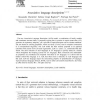Free Online Productivity Tools
i2Speak
i2Symbol
i2OCR
iTex2Img
iWeb2Print
iWeb2Shot
i2Type
iPdf2Split
iPdf2Merge
i2Bopomofo
i2Arabic
i2Style
i2Image
i2PDF
iLatex2Rtf
Sci2ools
87
Voted
TCS
2002
2002
Associative language descriptions
The new Associative Language Description (ALD) model, a combination of locally testable and constituent structure ideas, is proposed, arguing that in practice it equals context-free (CF) grammars in explanatory adequacy, yet it provides a simple description and it excludes mathematical sets based on counting properties, which are rarely (if ever) used in compiler construction or in computational linguistics. The ALD model has been recently proposed as an approach consistent with current views on brain organization. ALD is a "pure", i.e., nonterminal-free definition. The strict inclusion of ALD languages in CF languages is proved, based on a lemma which strengthens the Pumping Lemma for CF languages. Basic nonclosure and undecidability properties are considered and compared with those of CF languages. It is shown that the hardest context-free language is in ALD, that there exists a hierarchy of ALD languages and that each ALD tree language enjoys the noncounting property of p...
Related Content
| Added | 23 Dec 2010 |
| Updated | 23 Dec 2010 |
| Type | Journal |
| Year | 2002 |
| Where | TCS |
| Authors | Alessandra Cherubini, Stefano Crespi-Reghizzi, Pierluigi San Pietro |
Comments (0)

